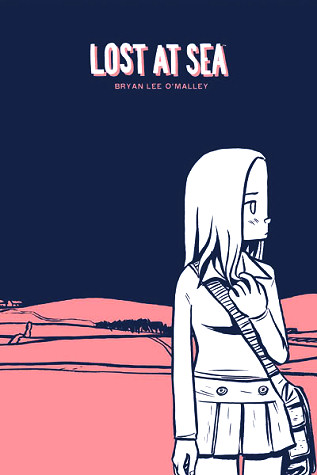
There may come a time in any young person's life when only questions have a sort of permanence. Everything else seems to be lost at sea, as it were.
Written by Bryan Lee O'Malley, Lost at Sea is a graphic novel about eighteen year-old Raleigh's coming to terms with her adolescence, on an awakening trip. After being picked up while visiting in California, she finds herself on a roadtrip across America back to Canada in the presence of her fellow Canadian travelers - and fellow adolescents - Ian Taylor, Dave Weldon, and Stephanie Ferguson: none of whom she really knows, except by name, even though she went to school with them. Thus begins Raleigh's dual journey, physical and emotional, through her misplacement amongst almost everything, including herself. And we the readers go along with their roadtrip to where ever it goes from here on in.
Throughout the graphic novel, on almost every page, emanates the feelings of perplexity and isolation. It's in the dialog, the art, and the overall structure. We are confidants to Raleigh's thoughts, where the story itself takes root and grows. Her thoughts have a sort of stream-of-consciousness flow to them. O'Malley, at times, makes sparse use of commas in certain places, which effectively conveys the sense of one thought being deeply connected to another and another thought adding to the stream. Eventually, whole thoughts and sentences themselves become adrift, reflecting Raleigh's situation as she sees it. Other times, the sentences are short and terse. They come clumped together as a linguistic pastiche. Some question. Some explore. Others ruminate. All of them reaching and searching for substance. However, not all of them are weighty meditations. In fact, quite a bit of the dialog consists of witty adolescent banter: Steph asks "How did Ian get so full of shit? Surgery?", to which Dave replies "Superior breeding, I think." When the focus is on Ian, Dave, and Steph, the interplay is fast, loud, drifting, obnoxious, and amusing. Raleigh? - she's quiet, well-spoken, and self-contained, for the most part. This juxtaposition of styles initially increases the sense of separation between Raleigh and the world itself. She speaks her own private language, in a loose sense. Nevertheless, also emanating is the feeling of nervous giddiness that one gets during novel experiences. The butterflies flutter and dance within us.
The artwork, too, plays into the story. It works "harmonically", adding an atmosphere more felt than distinctly sensed. From the front cover of Raleigh standing before a vast field, to her sitting quietly in the backseat which seems to encase her in shadows and space, the art provides a fitting environment both imposing and austere. With its heavy use of inks and shadows at the right times - especially towards the end - the settings recall childhood fears and wonders of things both upsetting and tranquil. The character designs themselves seem to personify a childlike quality. They are drawn quite simply, with enough features to make them look at home in a children's book. However, simplicity can express things clearer by virtue of its simplicity; it gets to the heart of the matter. Some of the feelings are heightened by a simple button-eyed glance or rubbery gesture. The designs magnify whatever it is the characters are expressing. It's affecting to see Raleigh and Stephanie share a quiet moment together. It's genuinely comical to witness an aggravated Ian go on a magnificent streak of profanity. Perhaps, the art itself attempts to reconcile childhood with adulthood.
Briefly, the entire work consists of one person's confronting all the hitherto confusing, discontinuous, painful, and - it's there if you look hard enough - hopeful elements in one's life. If the problems are here, then why shouldn't the resolutions be here as well? While the road to conciliation may lead us to thoughts such as "Everything beautiful is far away, or maybe, everything far away is beautiful", it also guides us home once we have decided to map our own way amongst the vastness of life itself. Of course, a little help from our friends never hurts.